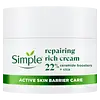What's inside
What's inside
 Key Ingredients
Key Ingredients

 Benefits
Benefits

 Concerns
Concerns

 Ingredients Side-by-side
Ingredients Side-by-side

Water
Skin ConditioningGlycerin
HumectantCaprylic/Capric Triglyceride
MaskingPolyglyceryl-3 Methylglucose Distearate
EmulsifyingPropanediol
SolventStearyl Alcohol
EmollientSodium Acrylate/Sodium Acryloyldimethyl Taurate Copolymer
Emulsion StabilisingStearic Acid
CleansingTapioca Starch
Dicaprylyl Ether
EmollientC15-19 Alkane
SolventCaprylyl Glycol
EmollientHydroxyacetophenone
AntioxidantPolyglyceryl-6 Laurate
EmulsifyingPanthenol
Skin ConditioningCitric Acid
BufferingCentella Asiatica Leaf Extract
Skin ConditioningPolyglycerin-6
HumectantSorbitan Oleate
EmulsifyingCetyl Alcohol
EmollientSorbitan Isostearate
EmulsifyingArachidyl Alcohol
EmollientTocopheryl Acetate
AntioxidantPantolactone
HumectantTocopherol
AntioxidantWater, Glycerin, Caprylic/Capric Triglyceride, Polyglyceryl-3 Methylglucose Distearate, Propanediol, Stearyl Alcohol, Sodium Acrylate/Sodium Acryloyldimethyl Taurate Copolymer, Stearic Acid, Tapioca Starch, Dicaprylyl Ether, C15-19 Alkane, Caprylyl Glycol, Hydroxyacetophenone, Polyglyceryl-6 Laurate, Panthenol, Citric Acid, Centella Asiatica Leaf Extract, Polyglycerin-6, Sorbitan Oleate, Cetyl Alcohol, Sorbitan Isostearate, Arachidyl Alcohol, Tocopheryl Acetate, Pantolactone, Tocopherol
Water
Skin ConditioningGlycerin
HumectantCyclopentasiloxane
EmollientDiglycerin
HumectantEthylhexyl Palmitate
EmollientSimmondsia Chinensis Seed Oil
EmollientBis-Diglyceryl Polyacyladipate-2
EmollientGlyceryl Stearate
EmollientIsopropyl Palmitate
EmollientImperata Cylindrica Root Extract
Skin ConditioningCarnosine
Skin ConditioningButyrospermum Parkii Butter
Skin ConditioningCetearyl Alcohol
EmollientPEG-100 Stearate
Caprylyl Glycol
EmollientSorbitol
HumectantBis-PEG-18 Methyl Ether Dimethyl Silane
EmollientAcrylates/C10-30 Alkyl Acrylate Crosspolymer
Emulsion StabilisingSodium PCA
HumectantButylene Glycol
HumectantAmmonium Acryloyldimethyltaurate/Vp Copolymer
Acrylamide/Sodium Acryloyldimethyltaurate Copolymer
Emulsion StabilisingDimethiconol
EmollientDimethicone
EmollientC13-14 Isoparaffin
EmollientGlutamine
Skin ConditioningCistus Incanus Flower/Leaf/Stem Extract
Skin ConditioningGynostemma Pentaphyllum Leaf/Stem Extract
AntioxidantSodium Hyaluronate
HumectantHyaluronic Acid
HumectantHydrolyzed Hyaluronic Acid
HumectantCeramide Ns
Skin ConditioningRosa Centifolia Flower Water
Skin ConditioningSodium Lactate
BufferingTrehalose
HumectantPhytosterols
Skin ConditioningSclerotium Gum
Emulsion StabilisingCarbomer
Emulsion StabilisingCitric Acid
BufferingPEG-8
HumectantAlteromonas Ferment Filtrate
HumectantCaprylhydroxamic Acid
Laureth-7
EmulsifyingHydrogenated Lecithin
EmulsifyingDecyl Glucoside
CleansingOctyldodecanol
EmollientTrihydroxystearin
Skin ConditioningGlucomannan
Skin ConditioningTrisodium Ethylenediamine Disuccinate
Water, Glycerin, Cyclopentasiloxane, Diglycerin, Ethylhexyl Palmitate, Simmondsia Chinensis Seed Oil, Bis-Diglyceryl Polyacyladipate-2, Glyceryl Stearate, Isopropyl Palmitate, Imperata Cylindrica Root Extract, Carnosine, Butyrospermum Parkii Butter, Cetearyl Alcohol, PEG-100 Stearate, Caprylyl Glycol, Sorbitol, Bis-PEG-18 Methyl Ether Dimethyl Silane, Acrylates/C10-30 Alkyl Acrylate Crosspolymer, Sodium PCA, Butylene Glycol, Ammonium Acryloyldimethyltaurate/Vp Copolymer, Acrylamide/Sodium Acryloyldimethyltaurate Copolymer, Dimethiconol, Dimethicone, C13-14 Isoparaffin, Glutamine, Cistus Incanus Flower/Leaf/Stem Extract, Gynostemma Pentaphyllum Leaf/Stem Extract, Sodium Hyaluronate, Hyaluronic Acid, Hydrolyzed Hyaluronic Acid, Ceramide Ns, Rosa Centifolia Flower Water, Sodium Lactate, Trehalose, Phytosterols, Sclerotium Gum, Carbomer, Citric Acid, PEG-8, Alteromonas Ferment Filtrate, Caprylhydroxamic Acid, Laureth-7, Hydrogenated Lecithin, Decyl Glucoside, Octyldodecanol, Trihydroxystearin, Glucomannan, Trisodium Ethylenediamine Disuccinate
 Reviews
Reviews

Ingredients Explained
These ingredients are found in both products.
Ingredients higher up in an ingredient list are typically present in a larger amount.
Caprylyl Glycol is a humectant and emollient, meaning it attracts and preserves moisture.
It is a common ingredient in many products, especially those designed to hydrate skin. The primary benefits are retaining moisture, skin softening, and promoting a healthy skin barrier.
Though Caprylyl Glycol is an alcohol derived from fatty acids, it is not the kind that can dry out skin.
This ingredient is also used as a preservative to extend the life of products. It has slight antimicrobial properties.
Learn more about Caprylyl GlycolCitric Acid is an alpha hydroxy acid (AHA) naturally found in citrus fruits like oranges, lemons, and limes.
Like other AHAs, citric acid can exfoliate skin by breaking down the bonds that hold dead skin cells together. This helps reveal smoother and brighter skin underneath.
However, this exfoliating effect only happens at high concentrations (20%) which can be hard to find in cosmetic products.
Due to this, citric acid is usually included in small amounts as a pH adjuster. This helps keep products slightly more acidic and compatible with skin's natural pH.
In skincare formulas, citric acid can:
While it can provide some skin benefits, research shows lactic acid and glycolic acid are generally more effective and less irritating exfoliants.
Most citric acid used in skincare today is made by fermenting sugars (usually from molasses). This synthetic version is identical to the natural citrus form but easier to stabilize and use in formulations.
Read more about some other popular AHA's here:
Learn more about Citric AcidGlycerin is already naturally found in your skin. It helps moisturize and protect your skin.
A study from 2016 found glycerin to be more effective as a humectant than AHAs and hyaluronic acid.
As a humectant, it helps the skin stay hydrated by pulling moisture to your skin. The low molecular weight of glycerin allows it to pull moisture into the deeper layers of your skin.
Hydrated skin improves your skin barrier; Your skin barrier helps protect against irritants and bacteria.
Glycerin has also been found to have antimicrobial and antiviral properties. Due to these properties, glycerin is often used in wound and burn treatments.
In cosmetics, glycerin is usually derived from plants such as soybean or palm. However, it can also be sourced from animals, such as tallow or animal fat.
This ingredient is organic, colorless, odorless, and non-toxic.
Glycerin is the name for this ingredient in American English. British English uses Glycerol/Glycerine.
Learn more about GlycerinWater. It's the most common cosmetic ingredient of all. You'll usually see it at the top of ingredient lists, meaning that it makes up the largest part of the product.
So why is it so popular? Water most often acts as a solvent - this means that it helps dissolve other ingredients into the formulation.
You'll also recognize water as that liquid we all need to stay alive. If you see this, drink a glass of water. Stay hydrated!
Learn more about Water